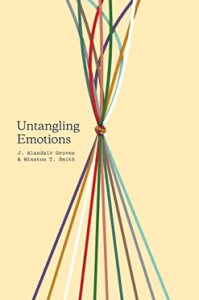
Emotions. What does that word evoke for you? Sometimes emotions can be overwhelming or welcomed; confusing or clear; all-consuming or we just don’t feel anything at all. Sometimes we’re not sure if what we’re feeling is godly. Often we just are not sure what we’re feeling at all.
I still remember how my body reacted when the nurse came back from the scan, suddenly less bubbly and chatty than before. My stomach dropped, the ‘butterflies’ increased, I’m pretty sure the blood drained from my face, I felt colder but sweaty and found it difficult to ‘act normal’. The emotion I was feeling would have been evident externally to anyone paying attention. I wasn’t the patient, but I knew there was bad news coming about someone I loved. Sitting in the back of an ambulance was never going to be a calming experience, but the anxiety I was experiencing was invading my whole being. Was my body driving my emotion or was my worry simply being worked out in my body?
For many years now I have learnt so much through material released by the Christian Counseling & Educational Foundation. Untangling Emotions is no exception. Although there are a few theories and more variations on where emotions originate from, Groves and Smith argue that where emotions originate from – either our bodies or our heads – is not our primary concern. Instead, our task is to understand what our emotions do in us.
“. . .the Bible places the focus on how our emotions facilitate (or impede) our role as God’s image bearers, helping us love him and one another (or hampering us from loving). Our emotions. . . are meant to function together in a way that serves his purposes. . . the Bible speaks to us as essentially unified persons, who were created with minds and bodies designed to work together seamlessly in our image-bearing tasks.” (p32)
The authors’ aim is to help us understand what emotions are and what to do about them; not just for others, but also for ourselves. The book is helpfully divided into three main parts: Understanding Emotions, Engaging Emotions and Engaging the Hardest Emotions. It’s not a difficult read in terms of the break-up of sections, chapters and language. However, to get the most from Groves and Smith it would be worthwhile to consider the questions at the end of each chapter. It’s heart work and heart work is always hard, but our growth in grace doesn’t come through disengaging. In fact, the authors encourage us to engage our emotions.
In Part 1 in the chapter What Exactly Are Emotions?, Groves and Smith outline what our emotions do:
• Communicate: emotions communicate value
• Relate: emotions help us to connect
• Motivate: emotions motivate us
• Elevate: emotions turn us toward God
Being beside the hospital bed that day, my anxiety drove me to pray – constantly cry out to God. I spoke to him about how I was feeling and asked him questions. “I don’t like this. Please help me be calm. Why is this happening now? Should I be so fearful? I know you’ve got everything in your care but I’m still shaken. Please don’t let my husband die.”
Knowing what emotions do helps us to better understand our own hearts – what we love – and to equip others to do the same. My anxiety over my husband’s health could have been for many reasons, but in that moment my response was to go to God – my emotions motivated me to turn to God. (Disclaimer: this may not always be my ‘go to’ response when I’m anxious.)
Isn’t it often the way – we start reading an article or book to help us understand or ‘fix’ others and we find that we have more broken bits than we realized? What’s your response when asked the question: how do you feel about how you feel? Mine was, “I’m not sure how I’m feeling half of the time and I don’t really want to look at that chaos too hard”! You can’t spend time in this book and not think about your own stuff. If you’re avoiding examining your emotions, there’s probably a greater need for you to do so.
Being reflective requires us to stop, stare and deal. It’s usually uncomfortable. “The way you respond to your emotions, including how you feel about how you feel, is of vital importance to your relationship with God and others in your life. Our emotions are one of the most common and commonly misunderstood opportunities in our lives to grow in maturity and love. They have the power to deeply enrich our relationships or drive wedges into them.” (p16) If we’re truly wanting to grow in our relationship with God and others then we should be willing to have a go at untangling our emotions.
Engaging emotions sounds a bit dangerous to some of us. Emotions are complicated and complex. There’s a reason why we talk about a ‘swirl’ of emotion. We’re almost always never just feeling one. It can be a bit messy in there. Emotions might be positive, negative, good or bad and even good negative and bad positive! The book is not about changing your emotions or trying to control them but “. . .it will give you suggestions at many levels, including things you can do with body and mind, to participate with God in a process of ongoing heart change.” (p80) This should be a joint venture. Doesn’t it make sense to explore your emotions with the one who made them?
Groves and Smith outline four steps in Part 2 for engaging emotions: identify (the emotion); examine (what the emotion is telling you); evaluate (what’s good and/or destructive about what you’re feeling) and act (“. . . embrace and nurture the loves of our heart and behaviours that are good. . . resist and even starve loves that are bad”). (pp94-98) What seems to be missing from this section comes into bold relief in the next chapter. We’re encouraged that prayer is not a step in this process, but engaging God – pouring our hearts out to him – should be an act we are engaged in constantly. Jesus did this – the one who “gives us a perfect picture of human emotions in action”. (p17) He didn’t keep his heart to himself and neither should we. When Jesus is filled with sorrow to the point of death, he turns to his Father and cries out to him.
Part 3 of Untangling Emotions is a practical guide which focusses on fear, anger, sorrow, guilt and shame – emotions I call ‘the big ones’. Having outlined a framework for engaging emotions in the previous section, each of these confusing emotions is explored in detail through that framework. The humility evident in Groves and Smith through their shared experience draws us in to think about the different facets of these troubling emotions. They provide helpful and practical things to do in response to these emotions. More than that, they teach us to value them – that there is a purpose now to these dark emotions that will one glorious day no longer be necessary. (p209) Our struggles now are not in vain. Our sanctification, including of our emotions, means we are becoming more like Jesus, our king who will one day return to take us to our home and rest where we will no longer struggle with but only enjoy our emotions.
Groves and Smith want to help us engage with our emotions in a godly way, in all their myriad forms. This is their desire for us, their readers. “In the meantime, we are right to delight in the comforts and blessings and joys and laughter God grants us. Yet we are also right to collapse on the ground and sob inconsolably, to bear on our hearts the weight of the dangers of those we love, and to set flinty eyes and clenched teeth against the evils that beset us. Now we sometimes laugh so hard we cry. Then all our crying will give way to laughter.” (p212)

